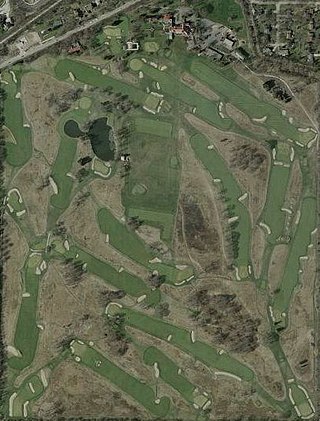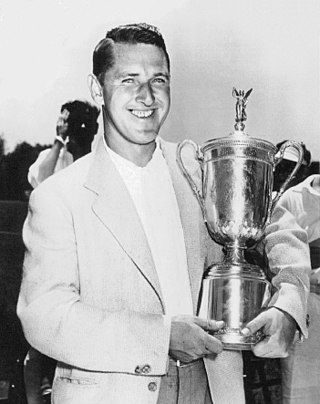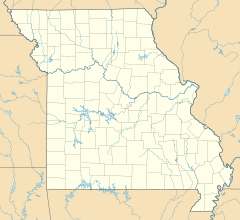
Samuel Jackson Snead was an American professional golfer who was one of the top players in the world for the better part of four decades and widely regarded as one of the greatest players of all time. Snead was awarded a record 94 gold medallions, for wins in PGA of America Tour events and later credited with winning a record 82 PGA Tour events tied with Tiger Woods, including seven majors. He never won the U.S. Open, though he was runner-up four times. Snead was inducted into the World Golf Hall of Fame in 1974.
The United States Open Championship, commonly known as the U.S. Open, is the annual open national championship of golf in the United States. It is the third of the four men's major golf championships, and is on the official schedule of both the PGA Tour and the European Tour. Since 1898 the competition has been 72 holes of stroke play, with the winner being the player with the lowest total number of strokes. It is staged by the United States Golf Association (USGA) in mid-June, scheduled so that, if there are no weather delays, the final round is played on the third Sunday. The U.S. Open is staged at a variety of courses, set up in such a way that scoring is very difficult, with a premium placed on accurate driving. As of 2023, the U.S. Open awards a $20 million purse, the largest of all four major championships.

Jack William Nicklaus, nicknamed "the Golden Bear", is a retired American professional golfer and golf course designer. He is widely considered to be either the greatest or one of the greatest golfers of all time. He won 117 professional tournaments in his career. Over a quarter-century, he won a record 18 major championships, three more than second-placed Tiger Woods. Nicklaus focused on the major championships—the Masters Tournament, U.S. Open, Open Championship and PGA Championship—and played a selective schedule of regular PGA Tour events. He competed in 164 major tournaments, more than any other player, and finished with 73 PGA Tour victories, third behind Sam Snead (82) and Woods (82).
The following is a partial timeline of the history of golf.
The Curtis Cup is the best known team trophy for women amateur golfers, awarded in the biennial Curtis Cup Match. It is co-organised by the United States Golf Association and The R&A and is contested by teams representing the United States and "Great Britain and Ireland". The same two teams originally contested the Ryder Cup, but unlike that competition, the Curtis Cup has not widened the Great Britain and Ireland team to include all Europeans. Many women who have gone on to become stars of women's professional golf have played in the Curtis Cup.

The United States Amateur Championship, commonly known as the U.S. Amateur, is the leading annual golf tournament in the United States for amateur golfers. It is organized by the United States Golf Association and is currently held each August over a 7-day period.

Chicago Golf Club is a private golf club in the central United States, located in Wheaton, Illinois, a suburb west of Chicago. The oldest 18-hole course in North America, it was one of the five founding clubs of the United States Golf Association (USGA) in 1894. It was listed on the National Register of Historic Places in 2020.
The following is a partial timeline of the history of golf.

Merion Golf Club is a private golf club which is located in Haverford Township, Delaware County, Pennsylvania, a township bordering Philadelphia to the northwest along the historic Main Line. The club has two courses: the East Course, and the West Course. The East Course has been consistently rated in the top 10, #5 in 2015, by Golf Digest in the annual "America's 100 Greatest Golf Courses", and it has hosted five U.S. Opens, most recently in 2013.

Lewis Elmer Worsham, Jr. was an American professional golfer, the U.S. Open champion in 1947.
Edgar Mason Rudolph was an American professional golfer who won five times on the PGA Tour.
Bandon Dunes Golf Resort is a complex of five links and a par-3 golf course on the West Coast of the United States, located alongside the Pacific Ocean in southwest Oregon, just north of the city of Bandon. For a history of Bandon Dunes, see founder Mike Keiser's book, The Nature of the Game, written with Stephen Goodwin.

Charles Blair Macdonald was a major figure in early American golf. He built the first 18-hole course in the United States, was a driving force in the founding of the United States Golf Association, won the first U.S. Amateur championship, and later built some of the most influential golf courses in the United States, to the extent that he is considered the father of American golf course architecture. He is a member of the World Golf Hall of Fame.
The 1960 U.S. Open was the 60th U.S. Open, held June 16–18 at Cherry Hills Country Club in Cherry Hills Village, Colorado, a suburb of Denver. Arnold Palmer staged the greatest comeback in U.S. Open history, erasing a seven-stroke deficit during the final round to win his only U.S. Open title. It is remembered as a crossroads for the three primary contenders in the final round: Palmer, Ben Hogan, and amateur Jack Nicklaus, three of the greatest players in the history of golf.
The 1948 U.S. Open was the 48th U.S. Open, held June 10–12 at Riviera Country Club in the northwest Los Angeles district of Pacific Palisades, California. Ben Hogan won the first of his four U.S. Open titles at the course that became known as "Hogan's Alley," as it was his third win at Riviera in less than 18 months. He had won the Los Angeles Open at the course in early 1947 and 1948. It was the third of Hogan's nine major titles; he had won his second PGA Championship a few weeks earlier. He was only the second to win both titles in the same year, joining Gene Sarazen in 1922. Later winners of both were Jack Nicklaus in 1980 and Tiger Woods in 2000.
The 1947 U.S. Open was the 47th U.S. Open, held June 12–15 at St. Louis Country Club in Ladue, Missouri, a suburb west of St. Louis. Lew Worsham denied Sam Snead his elusive U.S. Open title by prevailing in an 18-hole playoff. For Snead, it was his second of four career runner-up finishes at the Open.
The 1949 PGA Championship was the 31st PGA Championship, held May 25–31 in Virginia at Belmont Golf Course, north of Richmond. Native Virginian Sam Snead won the match play championship, 3 & 2 over Johnny Palmer in the Tuesday final; the winner's share was $3,500 and the runner-up's was $1,500.
The U.S. Women's Amateur is the leading golf tournament in the United States for female amateur golfers. It is played annually and is one of the 13 United States national golf championships organized by the United States Golf Association (USGA). Female amateurs from all nations are eligible to compete and there are no age restrictions. It was established in 1895, one month after the men's U.S. Amateur and U.S. Open. It is the third oldest USGA championship, over a half century older than the U.S. Women's Open, which was first played in 1946. Along with the British Ladies Amateur, the U.S. Women's Amateur is considered the highest honor in women's amateur golf.
The 38th Curtis Cup Match was played from June 6 to 8, 2014 at St. Louis Country Club in Ladue, Missouri. The United States won 13 to 7.











